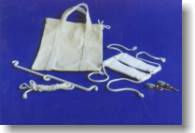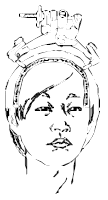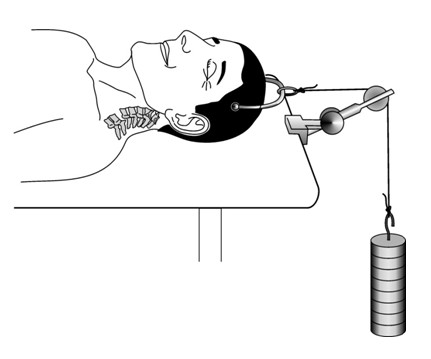Halter Traction
Halter traction is used for short term cervical traction. Uses include
minor neck injuries without obvious fractures e.g. Whiplash injury, neck
muscle spasm, conservative treatment of cervical disk lesions.
Children with cervical fractures can also be treated without skeletal
pins as their skull is too fragile to withstand pins.
 
Problems with Halter Traction
- Uncomfortable
- Tempero-mandibular pain
- Contraindicated in mandible fractures
- Difficult to control flexion - extension
Flexion Extension cervical X-rays
If a patient has normal cervical X-rays, but has neck muscle spasm Flexion
Extension views may be needed to exclude serious instability of the
cervical spine. Halter traction is a good way to relieve the spasm before
these X Rays can be done. The patient is admitted and placed in Halter
traction until the neck is free of muscular spasm. Under direct supervision
of the attending doctor the flexion extension views are taken in the X
ray department. The patient must have no pain when the neck is flexed
and extended. If neurological symptoms such as parasthesia develop the
X rays are abandoned.
Skull Traction
In more serious cervical injuries skull tongs such as Cones calipers
are indicated. Indications include the conservative treatment of cervical
fractures and dislocations.

Application of Cones Calipers
- Shave the hair above the ear region
- Local anaesthetic
- Avoid masseter
- Avoid Temporal artery
- Small incision above ear in line with auditory meatus
- Screw in pin until it just perforates outer table skull
- Tie on rope
- Attach weights
 |
| Position to apply
the Cone's Caliper pins - in line with auditory meatus |
 |
Crutchfield tongs:
Allow the patient to be easily turned, as the
caliper sits high on the skull. Consider these in a paralized
patient. |
Direction and Weights
- Force - 2.5 kg for head and 1/2 kg for each vertebra*
- Direction Neutral In line with Auditory meatus
- Flexion needed - raise pulley
- Extension needed - use double mattress ending @ shoulders
*(Each uninvolved
vertebra cephalad)
Complications of Cervical Traction
- Bleeding - temporal artery
- Pressure sore on skull - avoid downwards vector to rope
- Sepsis - from skin to subural abscess
- Worsening neurological status
- Squint from 6th craneal nerve fallout
Contraindications Skull Tongs
- Children
- Local sepsis
- Skull fracture
The double mattress method is an effective way to extend the neck. Never
place the head pulley too low as a pressure sore can result on the occiput,
especially in the unconscious or neurologically compromised patient.
At Tygerberg Hospital the Cone's calipers are commonly used. The Crutchfield
tongs are another caliper that fit higher on the skull vault and allow
easier turning of the paralised patient.
Reduction of Facet dislocations
Skeletal traction to the skull can be used to reduce cervical facet dislocations
 Weights
are serially added while the neck is positioned in flexion After each
2.5kg weight is added a lateral X ray is taken to determine reduction.
The attending doctor checks for neurological signs. If neurology deteriorates
the weights are removed. Up to 20 kg. traction may be used in this
way for a few hours only. After reduction the neck is placed in extension
and the lighter maintenance weights are used. Weights
are serially added while the neck is positioned in flexion After each
2.5kg weight is added a lateral X ray is taken to determine reduction.
The attending doctor checks for neurological signs. If neurology deteriorates
the weights are removed. Up to 20 kg. traction may be used in this
way for a few hours only. After reduction the neck is placed in extension
and the lighter maintenance weights are used.
|